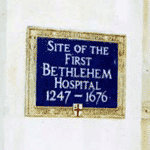Bedlam is a state of chaos or uproar but its original meaning was an insane asylum.
Bedlam is derived from the word Bethlehem as taken from the Hospital of St Mary of Bethlehem located outside Bishopsgate, in the City of London. The hospital was established in approximately 1330 as an attachment to the priory, established by Simon FitzMary in 1247.
The hospital was originally dedicated to the medical needs of impoverished people but began to admit ‘lunatics’ in 1377.
The care of these poor souls was little more than that of an animal, chained out of harm’s way and beaten or doused with water if they became too excited.
The priory and hospital came under the protection of the Mayor and the City of London in 1346 and in the 1500s was purchased by the City to continue the work of the asylum.
Bethlehem had already been shortened to Bedleem and Bedlem in Middle English and in the 16th century the hospital and its patients were commonly known by this name.
Bedlam came to mean ‘mad’, and even Shakespeare used the term in his Henry VI.
When the hospital was rehoused in 1676, the institution was opened to the public for inspection of the extraordinary architecture of the new building, but people also came to see the spectacle of the inmates.
From the beginning of the 17th century visitors paid a small fee to be allowed to go into the institution to ridicule the patients, chained in their cells.
The ‘entertainment’ was such that the crowds got fairly noisy and disorderly, which came to be known as bedlam.
The scenes of commotion and uproar at the hospital are what inspired the way we use the word today.


Recent Comments